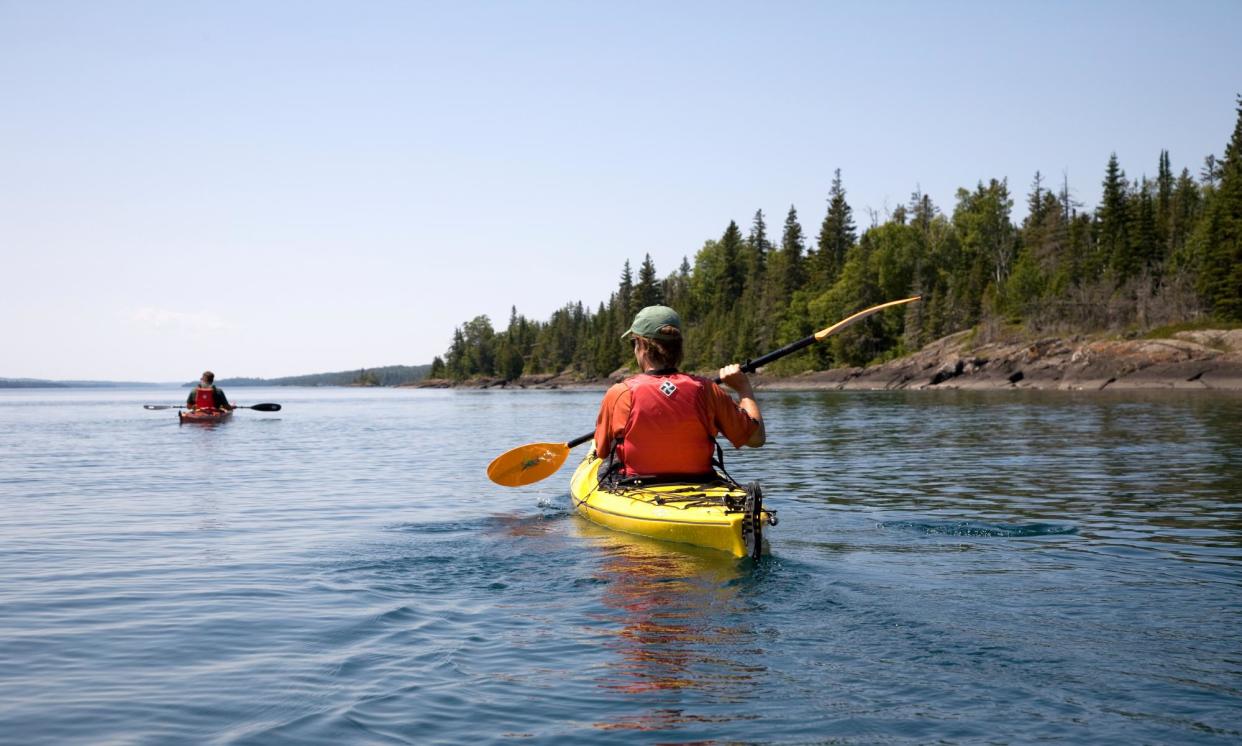The midwest is the US’s surprising new outdoor hotspot

At a nondescript mall in Beavercreek, a sleepy suburb in south-west Ohio, workers are unpacking the latest camping equipment, bikes and kayaks ahead of a grand opening of Ohio’s fifth REI co-op location.
Surrounded by farmland and leafy streetscapes in a region that relied on manufacturing and an air force base as its economic lifeblood for decades, Beavercreek and the wider post-industrial midwest might not quickly conjure up images of outdoor bliss.
But industry insiders see it differently: with 23 million members nationwide, REI’s Ohio membership has grown from around 80,000 in 2015 to 400,000 members today.
“There’s a campground right down the street, there’s a state park locally that has bolted top rope routes for climbing, there’s a mountain bike-only park,” says Sam Metcalf, the REI Beavercreek store manager. “You don’t have all that in most cities.”
While outdoor goods stores are closing in metro Los Angeles, San Francisco and Oregon, the post-industrial midwest is emerging as something of a new frontier as communities are figuring out that, with heavy manufacturing now in the rearview mirror, activating their rivers, trails and parklands is a surefire way to boost their economies.
This year REI is set to also open stores in Albany and Ithaca in upstate New York.
Research from the Outdoor Industry Association found that in recent years outdoor recreation participation is growing faster in the midwest and the middle Atlantic region that includes New York state than most other parts of the country.
Data that incorporates Ohio, Michigan, Wisconsin, Indiana and Illinois, shows that participation rates have grown by 6% between 2019 and 2023 – faster than a region that includes traditional outdoor hotspots such as California, Colorado and Montana.
REI hasn’t chosen these locations out of the blue. A five-minute drive from the new Beavercreek REI store lies a trailhead connected to the Great American Rail-Trail, an ambitious cross-country project that in the future would link Washington DC with the Pacific Ocean along a dedicated, continuous trail path. That, in turn, is close to the Little Miami River, a designated national scenic river that’s popular with fishers and paddlers.
Similar scenes are playing out in central and upstate New York.
During the second world war, close to 1,000 people were employed in the Ithaca Gun Factory, producing small arms for the US military and general consumer. By 1962, more than one in three workers in Ithaca’s Tompkins county were employed in manufacturing.
Since then, the city of around 100,000 people that’s a hub for the Finger Lakes region has pivoted to put its outdoor assets at the center of its economy. Visitors, many of whom are outdoor recreators, spend around $225m in Tompkins county every year, with Buttermilk Falls state park and its 500ft of cascades and rapids attracting more than 358,000 people in 2021.
“Outdoor recreation really took off after the pandemic in this region,” says Jennifer Wells, an outdoor recreation educator who runs Paddle-N-More, a watercraft rental company on the shores of Cayuga Lake north of Ithaca.
“The summer of 2020 and 2021 we saw about a 45% growth rate.”
Wells says that while she’s partly concerned for what it would mean for existing outdoor stores in Ithaca, she’s excited about REI coming to town.
“I always think about how do we develop as a destination area, and with the city of Ithaca and Tompkins county wanting to promote outdoor recreation … maybe REI will be a draw.”
Two hours north of Albany, a former manufacturing hub that’s also set to see an REI co-op store open this year, hundreds of millions of dollars are being invested into the region’s winter sports facilities in Lake Placid, the location of the 1980 Winter Olympics.
In Detroit’s northern suburbs, a $20m cleanup project has turned the Clinton River from an industrial dumping ground into a waterway that today sees thousands of kayakers and others paddle downstream into Lake St Clair.
But the pivot away from the region’s industrial past hasn’t always been straightforward. A region-wide legacy of industrial pollution means that places such as Detroit, Milwaukee and elsewhere are having to spend hundreds of millions of dollars in cleanup and remediation expenses alone.
Lead contamination from the site of the former Ithaca Gun Factory, situated a short distance from the stunning, 150ft-high Ithaca Falls, cost millions of dollars to clean up, with environmentalists claiming dangerous levels of chemicals remain.
In Grand Rapids, Michigan, plans to include whitewater features as part of a wider restoration initiative for the downtown section of the Grand River have been scrapped due to concerns posed by the Environmental Protection Agency. The project, which has been in the works for 15 years, would have seen several lowhead dams – a known drowning danger – removed and replaced with wave features. The EPA claimed the whitewater features could pose a safety hazard and in March and the City of Grand Rapids withdrew its permit application.
Still, with billions of government infrastructure dollars coming into the region expected to boost jobs and population growth in the years ahead, the outdoor industry upswing is set to continue.
“People are seeking outdoor recreation,” says Wells, who also runs a children’s adventure camp on Cayuga Lake, the longest of the 11 Finger Lakes.
“And Ithaca is a lovely place to be.”

